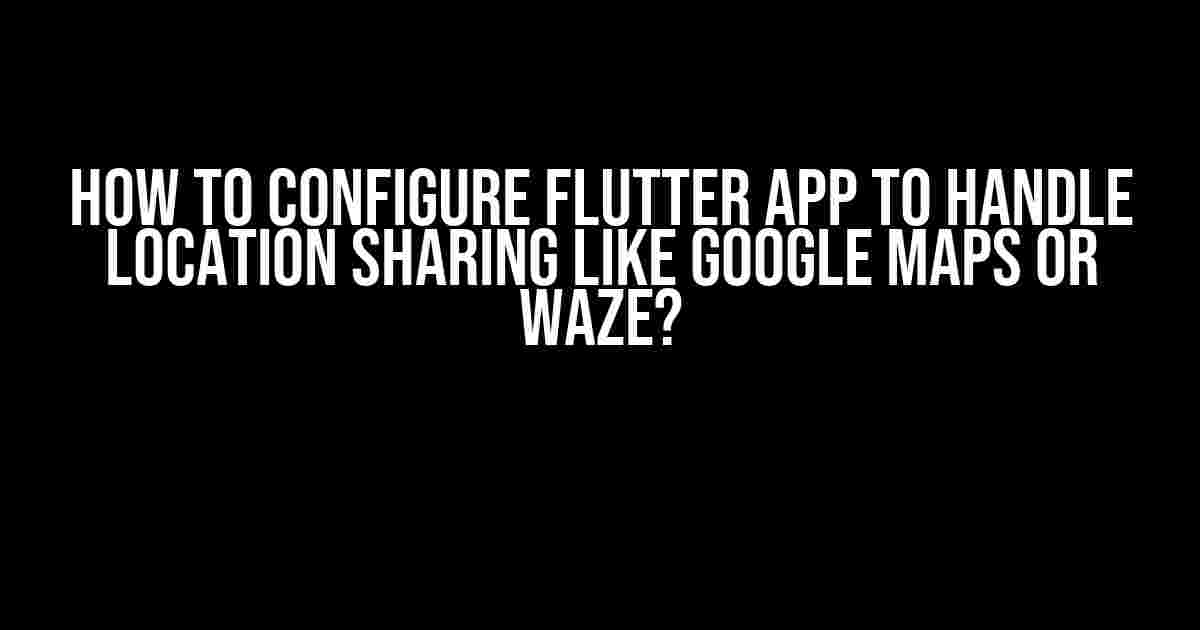Are you tired of creating Flutter apps that lack the robust location-sharing features of popular navigation apps like Google Maps or Waze? Do you want to take your app to the next level by allowing users to share their location in real-time? Look no further! In this article, we’ll dive into the step-by-step process of configuring a Flutter app to handle location sharing like a pro.
Prerequisites
Before we begin, make sure you have the following:
- Flutter installed on your machine (version 2.0 or later)
- A basic understanding of Dart programming language
- A Google Maps API key (optional but recommended)
Step 1: Add Location Permission
The first step is to request location permission from the user. This is crucial to access the device’s GPS and provide accurate location updates.
import 'package:flutter/material.dart';
import 'package:flutter/services.dart';
Future<void> _requestPermission() async {
final permission = await Permission.location.request();
if (permission.isGranted) {
print('Location permission granted');
} else {
print('Location permission denied');
}
}
In the above code, we import the necessary packages and create a `_requestPermission` function that requests location permission using the `Permission` class. You can call this function on app launch or when the user attempts to access location-sharing features.
Step 2: Create a Location Service
Next, we’ll create a location service that will handle location updates and provide them to our app.
import 'package:flutter/material.dart';
import 'package:location/location.dart';
class LocationService with ChangeNotifier {
final Location _location = Location();
Stream<LocationData> get locationStream => _location.onLocationChanged;
Future<void> _startLocationService() async {
await _location.requestPermission();
await _location.requestService();
}
}
In this example, we create a `LocationService` class that uses the `Location` package to request location permission and start the location service. We also expose a `locationStream` property that provides a stream of location updates.
Step 3: Consume Location Updates
Now, we’ll create a widget that consumes the location updates from our location service.
import 'package:flutter/material.dart';
import 'package:location_service/location_service.dart';
class LocationWidget extends StatefulWidget {
@override
_LocationWidgetState createState() => _LocationWidgetState();
}
class _LocationWidgetState extends State<LocationWidget> {
LocationService _locationService = LocationService();
@override
void initState() {
super.initState();
_locationService.locationStream.listen((locationData) {
print('Location updated: ${locationData.latitude}, ${locationData.longitude}');
});
}
@override
Widget build(BuildContext context) {
return Center(
child: Text('Location: unknown'),
);
}
}
In this example, we create a `LocationWidget` that consumes the location updates from our `LocationService` and prints the updated location coordinates to the console. You can replace the `Text` widget with a custom widget that displays the location on a map or provides driving directions.
Step 4: Implement Real-time Location Sharing
To share the user’s location in real-time, we’ll need to send the location updates to a server or a third-party service. For this example, we’ll use Firebase Realtime Database to share the location with other users.
import 'package:firebase_database/firebase_database.dart';
class LocationSharingService {
final FirebaseDatabase _database = FirebaseDatabase.instance;
Future<void> shareLocation(LocationData locationData) async {
await _database.reference().child('locations').child('user_id').set({
'latitude': locationData.latitude,
'longitude': locationData.longitude,
'timestamp': DateTime.now().millisecondsSinceEpoch,
});
}
}
In this example, we create a `LocationSharingService` that sends the location updates to Firebase Realtime Database. You can replace this with your own server or third-party service.
Step 5: Display Shared Locations on a Map
Finally, we’ll create a map widget that displays the shared locations from other users.
import 'package:flutter/material.dart';
import 'package:google_maps_flutter/google_maps_flutter.dart';
class MapWidget extends StatefulWidget {
@override
_MapWidgetState createState() => _MapWidgetState();
}
class _MapWidgetState extends State<MapWidget> {
final Completer<GoogleMapController> _mapController = Completer();
@override
Widget build(BuildContext context) {
return GoogleMap(
onMapCreated: (GoogleMapController controller) {
_mapController.complete(controller);
},
initialCameraPosition: CameraPosition(
target: LatLng(37.7749, -122.4194),
zoom: 12,
),
markers: _Markers().toSet(),
);
}
}
class _Markers with ChangeNotifier {
final List<Marker> _markers = [];
_Markers() {
_fetchMarkers();
}
Future<void> _fetchMarkers() async {
final locationSnapshots = await _database.reference().child('locations').once();
locationSnapshots.value.forEach((userId, locationData) {
final marker = Marker(
markerId: MarkerId(userId),
position: LatLng(locationData['latitude'], locationData['longitude']),
);
_markers.add(marker);
notifyListeners();
});
}
Set<Marker> getMarkers() => _markers.toSet();
}
In this example, we create a `MapWidget` that displays a Google Map with markers representing the shared locations from other users. We use Firebase Realtime Database to fetch the shared locations and update the map markers in real-time.
Optimization and Error Handling
To ensure a seamless user experience, it’s essential to optimize your app for various scenarios and handle errors gracefully.
Optimize Location Updates
You can optimize location updates by:
- Using a more efficient location provider (e.g., GPS, Wi-Fi, or cellular)
- Increasing the location update interval to conserve battery life
- Implementing location filtering to reduce noise and improve accuracy
Handle Errors and Exceptions
You should handle errors and exceptions by:
- Catching and logging errors using try-catch blocks
- Implementing fallback mechanisms for location services (e.g., using IP geolocation)
- Displaying error messages to the user (e.g., “Location permission denied”)
Conclusion
Configuring a Flutter app to handle location sharing like Google Maps or Waze requires a combination of location permission, location service, and real-time location sharing. By following these steps and optimizing your app for various scenarios, you can create a robust and user-friendly location-sharing feature that sets your app apart from the competition.
| Step | Description |
|---|---|
| 1 | Add location permission |
| 2 | Create a location service |
| 3 | Consume location updates |
| 4 | Implement real-time location sharing |
| 5 | Display shared locations on a map |
Remember to optimize your app for various scenarios and handle errors gracefully to ensure a seamless user experience. Happy coding!
Frequently Asked Question
Get ready to navigate your Flutter app like a pro! Here are some frequently asked questions on how to configure a Flutter app to handle location sharing like Google Maps or Waze:
Q1: What are the essential packages required to handle location sharing in a Flutter app?
To get started, you’ll need to add the following packages to your Flutter project: location, google_maps_flutter, and permission_handler. The location package allows you to access the device’s location, google_maps_flutter is used to display the map, and permission_handler is required to handle location permission requests.
Q2: How do I request location permission in a Flutter app?
To request location permission, you can use the PermissionHandler package. Simply call the requestLocationPermission method and handle the response accordingly. For example: PermissionHandler().requestLocationPermission(). Make sure to add the necessary permissions to your AndroidManifest.xml and Info.plist files as well.
Q3: How do I display a map in a Flutter app?
To display a map, you can use the GoogleMap widget from the google_maps_flutter package. Create a GoogleMapController and pass it to the GoogleMap widget. Then, use the CameraPosition to set the initial camera position and zoom level. For example: GoogleMap(initialCameraPosition: CameraPosition(target: LatLng(37.7749, -122.4194), zoom: 12.0)).
Q4: How do I get the user’s current location in a Flutter app?
To get the user’s current location, you can use the Location package. Call the getLocation method and handle the response accordingly. For example: Location().getLocation().then((location) => print(location.latitude)');. Make sure to handle the case where the user denies location permission or the location service is unavailable.
Q5: How do I share the user’s location in real-time in a Flutter app?
To share the user’s location in real-time, you can use a combination of the Location package and a real-time database or messaging service such as Firebase or Socket.io. Periodically update the user’s location in the database or send it to the server using WebSocket or HTTP requests. Then, on the receiving end, use the updated location to display the user’s location on the map.



